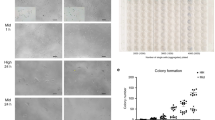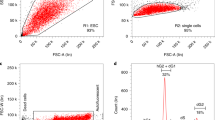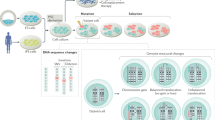Abstract
Cultured human embryonic stem (hES) cells can acquire genetic and epigenetic changes that make them vulnerable to transformation. As hES cells with cancer-cell characteristics share properties with normal hES cells, such as self-renewal, teratoma formation and the expression of pluripotency markers, they may be misconstrued as superior hES cells with enhanced 'stemness'. We characterize two variant hES cell lines (v-hESC-1 and v-hESC-2) that express pluripotency markers at high levels and do not harbor chromosomal abnormalities by standard cytogenetic measures. We show that the two lines possess some features of neoplastic progression, including a high proliferative capacity, growth-factor independence, a 9- to 20-fold increase in frequency of tumor-initiating cells, niche independence and aberrant lineage specification, although they are not malignant. Array comparative genomic hybridization reveals an amplification at 20q11.1-11.2 in v-hESC-1 and a deletion at 5q34a-5q34b;5q3 and a mosaic gain of chromosome 12 in v-hESC-2. These results emphasize the need for functional characterization to distinguish partially transformed and normal hES cells.
This is a preview of subscription content, access via your institution
Access options
Subscribe to this journal
Receive 12 print issues and online access
$209.00 per year
only $17.42 per issue
Buy this article
- Purchase on Springer Link
- Instant access to full article PDF
Prices may be subject to local taxes which are calculated during checkout




Similar content being viewed by others
Accession codes
References
Baker, D.E. et al. Adaptation to culture of human embryonic stem cells and oncogenesis in vivo. Nat. Biotechnol. 25, 207–215 (2007).
Caisander, G. et al. Chromosomal integrity maintained in five human embryonic stem cell lines after prolonged in vitro culture. Chromosome Res. 14, 131–137 (2006).
Inzunza, J. et al. Comparative genomic hybridization and karyotyping of human embryonic stem cells reveals the occurrence of an isodicentric X chromosome after long-term cultivation. Mol. Hum. Reprod. 10, 461–466 (2004).
Rosler, E.S. et al. Long-term culture of human embryonic stem cells in feeder-free conditions. Dev. Dyn. 229, 259–274 (2004).
Imreh, M.P. et al. In vitro culture conditions favoring selection of chromosomal abnormalities in human ES cells. J. Cell. Biochem. 99, 508–516 (2006).
Cowan, C.A. et al. Derivation of embryonic stem-cell lines from human blastocysts. N. Engl. J. Med. 350, 1353–1356 (2004).
Brimble, S.N. et al. Karyotypic stability, genotyping, differentiation, feeder-free maintenance, and gene expression sampling in three human embryonic stem cell lines derived prior to August 9, 2001. Stem Cells Dev. 13, 585–597 (2004).
Draper, J.S. et al. Recurrent gain of chromosomes 17q and 12 in cultured human embryonic stem cells. Nat. Biotechnol. 22, 53–54 (2004).
Maitra, A. et al. Genomic alterations in cultured human embryonic stem cells. Nat. Genet. 37, 1099–1103 (2005).
Enver, T. et al. Cellular differentiation hierarchies in normal and culture-adapted human embryonic stem cells. Hum. Mol. Genet. 14, 3129–3140 (2005).
Herszfeld, D. et al. CD30 is a survival factor and a biomarker for transformed human pluripotent stem cells. Nat. Biotechnol. 24, 351–357 (2006).
Mitalipova, M.M. et al. Preserving the genetic integrity of human embryonic stem cells. Nat. Biotechnol. 23, 19–20 (2005).
Ludwig, T.E. et al. Derivation of human embryonic stem cells in defined conditions. Nat. Biotechnol. 24, 185–187 (2006).
Yang, S. et al. Tumor progression of culture-adapted human embryonic stem cells during long-term culture. Genes Chromosom. Cancer 47, 665–679 (2008).
Ben-Porath, I. et al. An embryonic stem cell-like gene expression signature in poorly differentiated aggressive human tumors. Nat. Genet. 40, 499–507 (2008).
Lodish, H. et al. Molecular Cell Biology edn. 3 (W.H. Freeman & Co., New York, 1995).
Stewart, M.H. et al. Clonal isolation of hES cells reveals heterogeneity within the pluripotent stem cell compartment. Nat. Methods 3, 807–815 (2006).
Bendall, S.C. et al. IGF and FGF cooperatively establish the regulatory stem cell niche of pluripotent human cells in vitro. Nature 448, 1015–1021 (2007).
Hook, E.B. Exclusion of chromosomal mosaicism: tables of 90%, 95%, and 99% confidence limits and comments on use. Am. J. Hum. Genet. 29, 94–97 (1977).
Levenstein, M. et al. Basic fibroblast growth factor support of human embryonic stem cell self-renewal. Stem Cells 24, 568–574 (2004).
Lensch, M.W. & Ince, T.A. The terminology of teratocarcinomas and teratomas. Nat. Biotechnol. 25, 1211 author reply, 1211–1212 (2007).
Damjanov, I. & Andrews, P.W. The terminology of teratocarcinomas and teratomas. Nat. Biotechnol. 25, 1212 editorial reply, 1212 (2007).
Boyer, L.A. et al. Core transcriptional regulatory circuitry in human embryonic stem cells. Cell 122, 947–956 (2005).
Lee, T.I. et al. Control of developmental regulators by Polycomb in human embryonic stem cells. Cell 125, 301–313 (2006).
Boyer, L.A. et al. Polycomb complexes repress developmental regulator in murine embryonic stem cells. Nature 441, 349–353 (2006).
Spits, C. et al. Recurrent chromosomal abnormalities in human embryonic stem cells. Nat. Biotechnol. 26, 1361–1363 (2008).
Lefort, N. et al. Human embryonic stem cells reveal recurrent genomic instability at 20q11.21. Nat. Biotechnol. 26, 1364–1366 (2008).
Singh, S.K. et al. Identification of human brain tumour initiating cells. Nature 432, 396–401 (2004).
O'Brien, C.A., Pollett, A., Gallinger, S. & Dick, J.E. A human colon cancer cell capable of initiating tumour growth in immunodeficient mice. Nature 445, 106–110 (2007).
Ricci-Vitiani, L. et al. Identification and expansion of human colon-cancer-initiating cells. Nature 445, 111–115 (2007).
Shmelkov, S.V. et al. CD133 expression is not restricted to stem cells, and both CD133+ and CD133– metastatic colon cancer cells initiate tumors. J. Clin. Invest. 118, 2111–2120 (2008).
Postovit, L.M. et al. Human embryonic stem cell microenvironment suppresses the tumorigenic phenotype of aggressive cancer cells. Proc. Natl. Acad. Sci. USA 105, 4329–4334 (2008).
Chadwick, K. et al. Cytokines and BMP-4 promote hematopoietic differentiation of human embryonic stem cells. Blood 102, 906–915 (2003).
Acknowledgements
This work was funded by the Canadian Institute of Health Research, the National Cancer Institute of Canada (NCIC), Ontario Institute of Cancer Research (OICR) and the Canadian Cancer Society (CCS). A fellowship from the NCIC supports T.E.W.-O. and support to M.B. from the Canada Research Chair Program. In addition, thanks to Jiabi Yang for technical support in scoring teratoma formation assays and members of the Stem Cell and Cancer Research Institute for helpful insights during the writing of the manuscript.
Author information
Authors and Affiliations
Contributions
T.E.W.-O. performed and designed experiments, analyzed data and assisted in writing the manuscript. M.B., M.S., V.R.-M., A.R., T.W., S.D., T.C., C.W. (from PerkinElmer) and C.H. performed experiments. A.S. analyzed bioinformatics data, and M.-J.S. conducted histological analysis. J.D., C.W. (from McMaster) and D.B. were collaborators on the paper. M.B. designed experiments, interpreted and assisted in writing the manuscript.
Corresponding author
Supplementary information
Supplementary Text and Figures
Supplementary Figures 1-6, Supplementary Tables 1 and 2 and Supplementary Methods (PDF 1195 kb)
Rights and permissions
About this article
Cite this article
Werbowetski-Ogilvie, T., Bossé, M., Stewart, M. et al. Characterization of human embryonic stem cells with features of neoplastic progression. Nat Biotechnol 27, 91–97 (2009). https://doi.org/10.1038/nbt.1516
Received:
Accepted:
Published:
Issue Date:
DOI: https://doi.org/10.1038/nbt.1516
This article is cited by
-
Human Umbilical Cord–derived Mesenchymal Stem Cells into Oligodendrocyte-like Cells using Triiodothyronine as an Inducer: a Rapid and Efficient Protocol
Regenerative Engineering and Translational Medicine (2023)
-
TPX2 Amplification-Driven Aberrant Mitosis in Culture Adapted Human Embryonic Stem Cells with gain of 20q11.21
Stem Cell Reviews and Reports (2023)
-
Emerging role of G9a in cancer stemness and promises as a therapeutic target
Oncogenesis (2021)
-
G9a controls pluripotent-like identity and tumor-initiating function in human colorectal cancer
Oncogene (2021)
-
Immunological considerations and challenges for regenerative cellular therapies
Communications Biology (2021)



